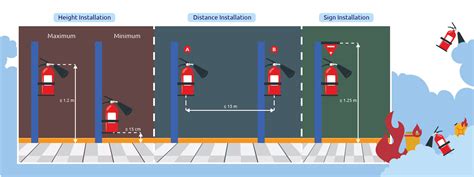Fire Extinguisher Height: A Landlord's Responsibility
Landlords have a legal and moral obligation to ensure the safety and well-being of their tenants. A crucial aspect of this responsibility involves providing and maintaining adequate fire safety equipment, including fire extinguishers. But where should these vital safety devices be placed? The height of a fire extinguisher is a critical factor often overlooked, leading to potential liabilities and compromised safety. This article will explore the legal requirements and best practices surrounding fire extinguisher placement height, specifically focusing on a landlord's responsibilities.
What is the Ideal Height for a Fire Extinguisher?
There's no single universally mandated height for fire extinguisher placement. However, best practices and building codes generally recommend placing them within easy reach of occupants, ideally between 3.5 and 4.5 feet from the floor. This height ensures that most adults can readily access the extinguisher without needing to stretch or strain, allowing for quick and efficient response in an emergency. Consider the average height of your tenants and ensure accessibility for all.
Remember, the goal is accessibility, not strict adherence to a specific measurement. Obstructions, such as furniture or equipment, should also be factored in, ensuring a clear and unobstructed path to the extinguisher.
Why is the Height so Important?
Seconds matter in a fire. If a fire extinguisher is placed too high or in an inaccessible location, precious time is wasted in retrieving it, allowing the fire to spread and potentially endangering lives and property. A readily accessible fire extinguisher significantly improves the chances of containing a small fire before it escalates into a major emergency.
Landlord Responsibilities Regarding Fire Extinguisher Placement
Landlords are responsible for providing and maintaining functional fire extinguishers in their rental properties. This responsibility extends to ensuring their correct placement, including the appropriate height. Failure to do so can lead to serious consequences, including:
- Legal Penalties: Depending on local regulations and the severity of the consequences of improper placement, landlords can face hefty fines or legal action.
- Insurance Issues: Insurance companies may refuse to cover fire-related damages if the landlord is found to be negligent in maintaining proper fire safety measures, including the correct placement of extinguishers.
- Liability for Injuries or Damages: In case of a fire, a landlord could be held liable for injuries or property damage if the inaccessibility of the fire extinguisher hindered its effective use.
Are there specific regulations for fire extinguisher height?
While there isn't a nationally standardized height regulation for fire extinguishers in the US, local fire codes and building regulations often dictate specific requirements. These codes vary from state to state and even from municipality to municipality. Landlords must consult their local fire marshal or building department to understand the specific regulations applicable to their rental properties. These codes often specify not only height but also the number and type of extinguishers required based on the size and type of building.
What about different types of fire extinguishers and their placement?
The type of fire extinguisher (e.g., Class A, B, C, K) impacts its intended use and, to a lesser extent, its placement. While the general accessibility guidelines remain consistent, certain locations might be more suitable for specific types based on the likely fire hazards present in that area. Consult with a fire safety professional to determine the most appropriate extinguisher types and their placement for your specific property.
What if my building has accessibility concerns?
For buildings with occupants who may have mobility limitations, extra considerations are necessary. Ensure at least one fire extinguisher is placed at a height easily reachable by individuals using wheelchairs or other mobility aids. Consulting with an accessibility specialist can ensure compliance with the Americans with Disabilities Act (ADA) and other relevant regulations.
Regular Inspections and Maintenance are Key
Beyond proper placement, landlords must conduct regular inspections and ensure the extinguishers are properly maintained and serviced. This includes checking the pressure gauge, ensuring the extinguisher is not damaged or obstructed, and scheduling regular professional servicing as required by the manufacturer. Documentation of these inspections and maintenance is crucial for demonstrating compliance with safety regulations and protecting the landlord's liability.
In conclusion, the height of a fire extinguisher is a critical factor in ensuring the safety of tenants and minimizing potential risks. Landlords must prioritize proper placement in accordance with local regulations and best practices, demonstrating their commitment to providing a safe living environment. Neglecting this responsibility can have serious legal and financial repercussions. Regular inspections and proactive maintenance are equally vital in upholding fire safety standards and fulfilling a landlord's duty of care.

